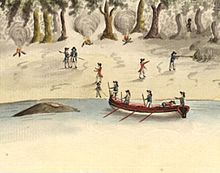| Hawkesbury Settlement | |||||||
|---|---|---|---|---|---|---|---|
| Part of the Australian frontier wars | |||||||
 Governor Arthur Phillip speared during a skirmish at Manly (1790). | |||||||
| |||||||
| Belligerents | |||||||
|
|
Indigenous clans:
| ||||||
| Commanders and leaders | |||||||
|
|
Pemulwuy † Tedbury † Yaragowhy † Woglomigh † Obediah Ikins Musquito (POW) John Wilson William Knight | ||||||
| Strength | |||||||
|
Armed settlers: 2,000+ Burreberongal Tribe (1790–1802) 100+ Combined total force: 3,600 |
Indigenous clan numbers: approx. 3,000 About 10+ armed Irish convicts 2 or more bushrangers[1] | ||||||
| Casualties and losses | |||||||
|
Total Casualties: ~300 ('conservative estimate')[2] Dead: at least 80 confirmed Wounded: bare minimum of 74 |
Dead: 80 confirmed (many likely went unrecorded)[2] Wounded: +100 | ||||||
The Hawkesbury and Nepean Wars (1794–1816) were a series of conflicts where British forces, including armed settlers and detachments of the British Army in Australia, fought against Indigenous clans inhabiting the Hawkesbury River region and the surrounding areas to the west of Sydney. The wars began in 1794, when the British started to construct farms along the river, some of which were established by soldiers.[3]
The local Darug people raided farms and murdered settlers until Governor Macquarie dispatched troops from the 46th Regiment of Foot in 1816. These troops patrolled the Hawkesbury Valley and ended the conflict by killing 14 Indigenous Australians in a raid on their campsite.[4] Indigenous Australians led by Pemulwuy also conducted raids around Parramatta during the period between 1795 and 1802. These attacks led Governor Philip Gidley King to issue an order in 1801 which authorized settlers to shoot Indigenous Australians on sight in Parramatta, Georges River and Prospect areas.[5]
Many of the Aboriginal nations occasionally allied themselves to the British settlers in order to conquer more land for their tribes, and just as quickly returned to a state of war against the settlers. It was fought using mostly guerrilla-warfare tactics; however, several conventional battles also took place. The engagement resulted in the defeat of the Hawkesbury river and Nepean river Indigenous clans who were subsequently dispossessed of their lands.[6]
With the expansion of European settlement, large amounts of land was cleared for farming, which resulted in the destruction of Aboriginal food sources. This, combined with the introduction of new diseases such as smallpox, caused resentment within the Aboriginal clans against the settlers and resulted in violent confrontations, coordinated by men such as Pemulwuy.[7]
- ^ Knight, Ian (2019). Australian Bushrangers 1788–1880. Oxford: Osprey Publishing. p. 7. ISBN 978-1472831101.
- ^ a b Gapps, Stephen (2018). The Sydney Wars. NewSouth Publishing. p. Epilogue, subheading: Served in the war. ISBN 9781742232140.
- ^ Macintyre, Stuart (1999). A Concise History of Australia. Cambridge Concise Histories (First ed.). Cambridge: Cambridge University Press. ISBN 0-521-62577-7.
- ^ Connor, John (2002). The Australian frontier wars, 1788–1838. Sydney: UNSW Press. ISBN 0-86840-756-9.
- ^ Kohen, J. L. (2005). "Pemulwuy (c. 1750 – 1802)". Australian Dictionary of Biography. National Centre of Biography, Australian National University. ISSN 1833-7538. Retrieved 12 July 2009.
- ^ Wendy Lewis, Simon Balderstone and John Bowan (2006). Events That Shaped Australia. New Holland. ISBN 978-1-74110-492-9.
- ^ "Pemulwuy". Retrieved 6 May 2017.
© MMXXIII Rich X Search. We shall prevail. All rights reserved. Rich X Search
